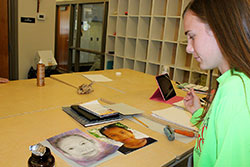Making a memory: Chatard art students create portraits for disadvantaged youths in Cambodia

Bishop Chatard High School senior Kate Phelps pauses to examine her portrait of a Cambodian child before adding her final touches to the art work. (Submitted photo)
By John Shaughnessy
As an artist, Elaine Carson knows that inspiration can come from almost anywhere.
Still, when the longtime art teacher at Bishop Chatard High School in Indianapolis wanted her advanced students to use their talents to touch the lives and hearts of others, Carson found her inspiration close to home—in the volunteer efforts of her son, Matt, in poverty-stricken areas of Cambodia.
That inspiration led her students to become part of The Memory Project—an effort that connects young American art students with orphaned, abused and neglected children from around the world.
“I heard about the project a couple of years ago in one of my art magazines, but I was a little skeptical at first,” Carson says. “My son, Matt, started doing Habitat for Humanity in Cambodia, building homes there. He said the thing that strikes him is that they’re happy, happy people. The kids don’t have much, but they’re skipping, dancing and laughing. They’re such a loving group of people.”
Her son’s perception led Carson to contact Ben Schumaker, founder of The Memory Project.
“I asked him if they went to Cambodia, and he said they go there once a year,” Carson says. “I asked him if my students could do The Memory Project for Cambodian kids. He said they could.”
Capturing a piece of childhood
The goal of The Memory Project is simple and heartfelt.
“The Memory Project is a unique initiative in which art students create portraits for children and teens around the world who have been neglected, orphaned or disadvantaged,” notes a statement on the project’s website, www.memoryproject.org. “Given that kids in such situations tend to have few personal keepsakes, we’re aiming to provide them with special memories that capture a piece of their childhood.
“As much as possible, we also want to help the kids see themselves as works of art. To do this, art students receive photos of kids on our waiting list and then work in any medium to create the portraits. Next, we deliver the portraits to the kids as gifts. We also take photos of the kids holding the portraits so the art students can see the delivery in action.”
Schumaker started the project after volunteering at an orphanage in Guatemala. He noticed that that the children already had “people taking care of their basic needs of food, health care and education.” What they didn’t have were any special belongings that represented their childhood.
So Schumaker decided to “go beyond the basic needs to touch the kids’ lives in a fun, artistic way.”
That approach was both a blessing and a challenge for the seven students in Carson’s Advanced Placement Art Studio course.
“When I heard the word ‘portrait,’ I said, ‘You’re joking. I do not draw people,’ ” says Maddie Bernauer, a senior who is a member of St. Simon the Apostle Parish in Indianapolis. “But when I heard that we were doing it for orphans, I said I’ll give it a try.”
A special touch
The process of trying to capture the Cambodian children and teens in a portrait had different impacts on the students.
Several of the students noted how they felt a connection with the children.
Chad Reynolds recalls the four weeks he spent focusing on the face of a Cambodian child named Barraing.
“You spend so long looking at him that you feel you know him a little better,” says Chad, a senior who is a member of St. Luke the Evangelist Parish in Indianapolis.
Brendan Smith set aside his usual preference for animation to focus on the real features of a child named Sokleng.
“He has a scar on his eyebrow so I wanted to share that detail,” says Brendan, a senior who is a member of St. Lawrence Parish in Indianapolis. “It made me want to know more about him. I thought he had a cool smile, too. And given what he’s probably gone through, it made it more special.”
Kristen Roney succinctly expressed the feelings of her fellow students when they finished the portraits.
“It just felt good,” says Kristen, a senior and member of St. Thomas Aquinas Parish in Indianapolis.
Another kind of gift
Before the portraits were shipped, the students attached a photo of themselves to the back of their art work.
“I hope he really likes it,” says Anna Muchler, a senior who is a member of St. Monica Parish in Indianapolis. “That’s why we felt there was so much pressure—that if they got it and didn’t think it looked like them, it would be disappointing.”
While the students are still waiting to receive photos of the children holding their portraits, Carson views their artistic efforts for The Memory Project as another dimension of a Catholic school’s commitment to service.
“I like to get them to think beyond themselves,” Carson says. “Until this year, everything they’ve done in art has been about them. It makes their work personal, but this was for someone else. We want them to know they can use their work to show their compassion, to do something from the heart for others. I told them to put something in their work that expressed how they felt about the child—to make the child feel good about themselves, to make them feel special.
“And they did that. It was another kind of gift.” †
